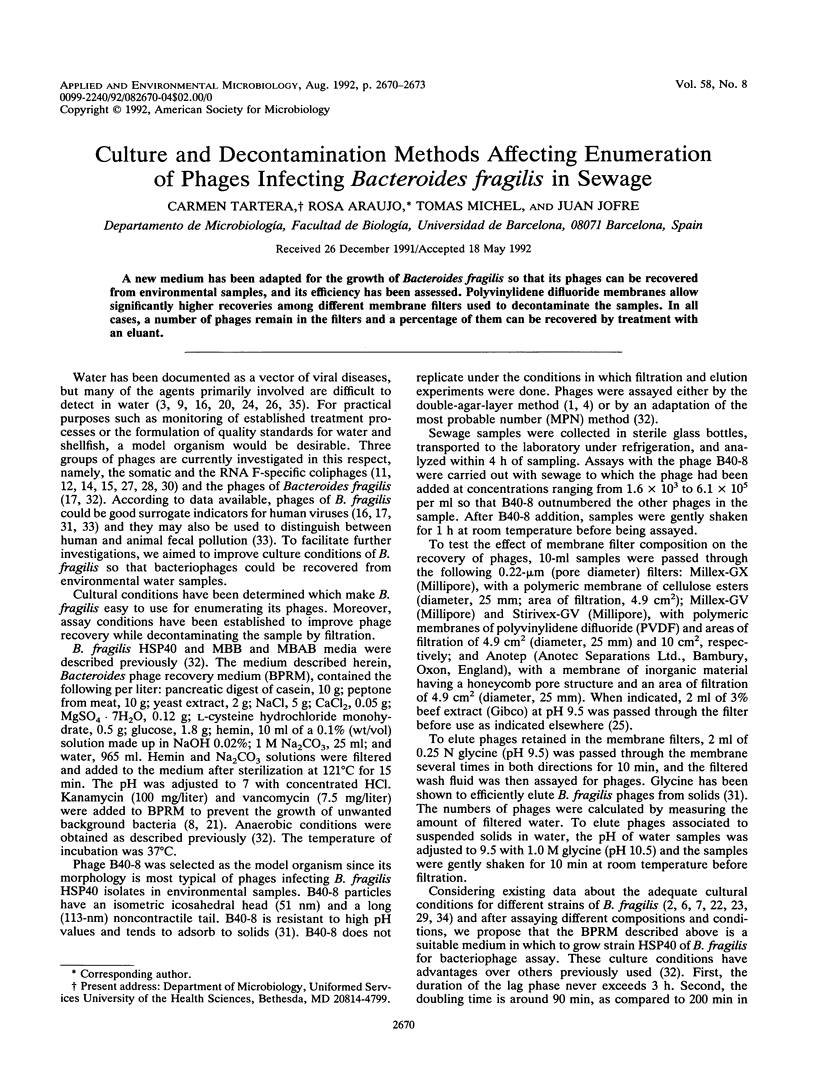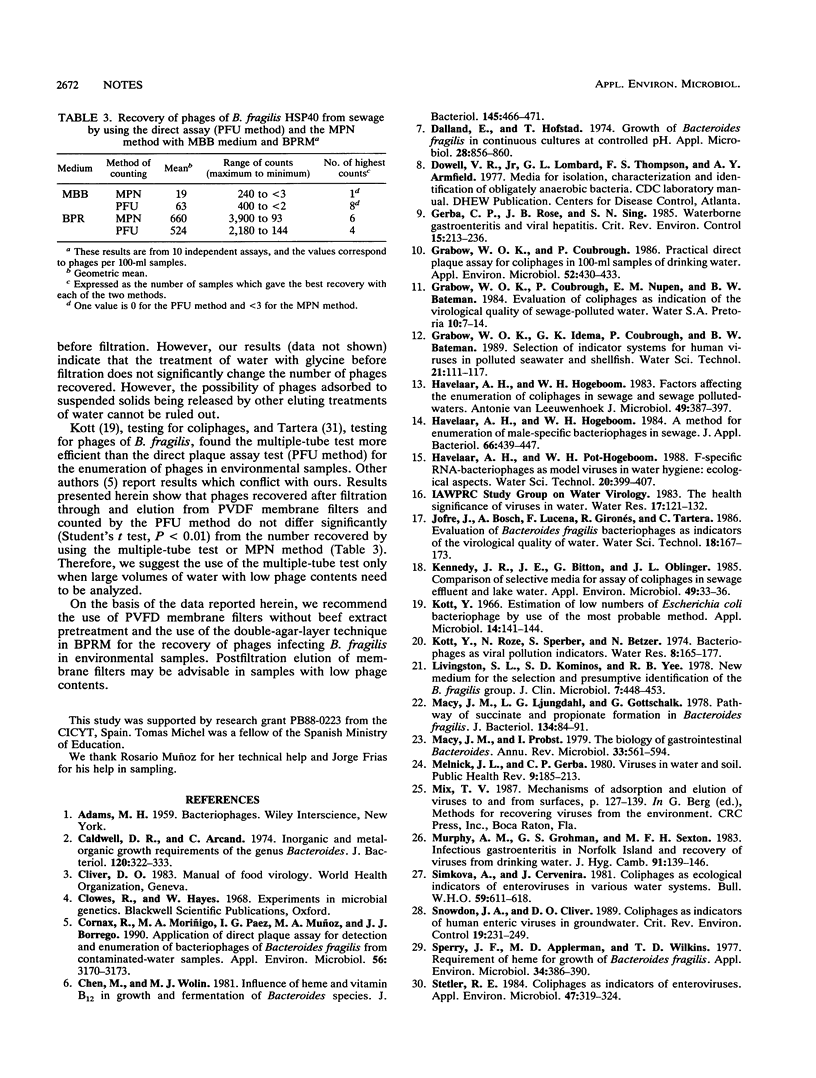Abstract
A new medium has been adapted for the growth of Bacteroides fragilis so that its phages can be recovered from environmental samples, and its efficiency has been assessed. Polyvinylidene difluoride membranes allow significantly higher recoveries among different membrane filters used to decontaminate the samples. In all cases, a number of phages remain in the filters and a percentage of them can be recovered by treatment with an eluant.
Full text
PDF



Selected References
These references are in PubMed. This may not be the complete list of references from this article.
- Caldwell D. R., Arcand C. Inorganic and metal-organic growth requirements of the genus Bacteroides. J Bacteriol. 1974 Oct;120(1):322–333. doi: 10.1128/jb.120.1.322-333.1974. [DOI] [PMC free article] [PubMed] [Google Scholar]
- Chen M., Wolin M. J. Influence of heme and vitamin B12 on growth and fermentations of Bacteroides species. J Bacteriol. 1981 Jan;145(1):466–471. doi: 10.1128/jb.145.1.466-471.1981. [DOI] [PMC free article] [PubMed] [Google Scholar]
- Cornax R., Moriñigo M. A., Paez I. G., Muñoz M. A., Borrego J. J. Application of direct plaque assay for detection and enumeration of bacteriophages of Bacteroides fragilis from contaminated-water samples. Appl Environ Microbiol. 1990 Oct;56(10):3170–3173. doi: 10.1128/aem.56.10.3170-3173.1990. [DOI] [PMC free article] [PubMed] [Google Scholar]
- Dalland E., Hofstad T. Growth of Bacteroides fragilis in continuous culture and in batch cultures at controlled pH. Appl Microbiol. 1974 Nov;28(5):856–860. doi: 10.1128/am.28.5.856-860.1974. [DOI] [PMC free article] [PubMed] [Google Scholar]
- Grabow W. O., Coubrough P. Practical direct plaque assay for coliphages in 100-ml samples of drinking water. Appl Environ Microbiol. 1986 Sep;52(3):430–433. doi: 10.1128/aem.52.3.430-433.1986. [DOI] [PMC free article] [PubMed] [Google Scholar]
- Havelaar A. H., Hogeboom W. M. A method for the enumeration of male-specific bacteriophages in sewage. J Appl Bacteriol. 1984 Jun;56(3):439–447. doi: 10.1111/j.1365-2672.1984.tb01372.x. [DOI] [PubMed] [Google Scholar]
- Havelaar A. H., Hogeboom W. M. Factors affecting the enumeration of coliphages in sewage and sewage-polluted waters. Antonie Van Leeuwenhoek. 1983 Nov;49(4-5):387–397. doi: 10.1007/BF00399318. [DOI] [PubMed] [Google Scholar]
- Kennedy J. E., Jr, Bitton G., Oblinger J. L. Comparison of selective media for assay of coliphages in sewage effluent and lake water. Appl Environ Microbiol. 1985 Jan;49(1):33–36. doi: 10.1128/aem.49.1.33-36.1985. [DOI] [PMC free article] [PubMed] [Google Scholar]
- Kott Y. Estimation of low numbers of Escherichia coli bacteriophage by use of the most probable number method. Appl Microbiol. 1966 Mar;14(2):141–144. doi: 10.1128/am.14.2.141-144.1966. [DOI] [PMC free article] [PubMed] [Google Scholar]
- Livingston S. J., Kominos S. D., Yee R. B. New medium for selection and presumptive identification of the Bacteroides fragilis group. J Clin Microbiol. 1978 May;7(5):448–453. doi: 10.1128/jcm.7.5.448-453.1978. [DOI] [PMC free article] [PubMed] [Google Scholar]
- Macy J. M., Ljungdahl L. G., Gottschalk G. Pathway of succinate and propionate formation in Bacteroides fragilis. J Bacteriol. 1978 Apr;134(1):84–91. doi: 10.1128/jb.134.1.84-91.1978. [DOI] [PMC free article] [PubMed] [Google Scholar]
- Macy J. M., Probst I. The biology of gastrointestinal bacteroides. Annu Rev Microbiol. 1979;33:561–594. doi: 10.1146/annurev.mi.33.100179.003021. [DOI] [PubMed] [Google Scholar]
- Melnick J. L., Gerba C. P. Viruses in water and soil. Public Health Rev. 1980 Jul-Dec;9(3-4):185–213. [PubMed] [Google Scholar]
- Murphy A. M., Grohmann G. S., Sexton M. F. Infectious gastroenteritis in Norfolk Island and recovery of viruses from drinking water. J Hyg (Lond) 1983 Aug;91(1):139–146. doi: 10.1017/s0022172400060113. [DOI] [PMC free article] [PubMed] [Google Scholar]
- Simková A., Cervenka J. Coliphages as ecological indicators of enteroviruses in various water systems. Bull World Health Organ. 1981;59(4):611–618. [PMC free article] [PubMed] [Google Scholar]
- Sperry J. F., Appleman M. D., Wilkins T. D. Requirement of heme for growth of Bacteroides fragilis. Appl Environ Microbiol. 1977 Oct;34(4):386–390. doi: 10.1128/aem.34.4.386-390.1977. [DOI] [PMC free article] [PubMed] [Google Scholar]
- Stetler R. E., Ward R. L., Waltrip S. C. Enteric virus and indicator bacteria levels in a water treatment system modified to reduce trihalomethane production. Appl Environ Microbiol. 1984 Feb;47(2):319–324. doi: 10.1128/aem.47.2.319-324.1984. [DOI] [PMC free article] [PubMed] [Google Scholar]
- Tartera C., Jofre J. Bacteriophages active against Bacteroides fragilis in sewage-polluted waters. Appl Environ Microbiol. 1987 Jul;53(7):1632–1637. doi: 10.1128/aem.53.7.1632-1637.1987. [DOI] [PMC free article] [PubMed] [Google Scholar]
- Tartera C., Lucena F., Jofre J. Human origin of Bacteroides fragilis bacteriophages present in the environment. Appl Environ Microbiol. 1989 Oct;55(10):2696–2701. doi: 10.1128/aem.55.10.2696-2701.1989. [DOI] [PMC free article] [PubMed] [Google Scholar]
- Varel V. H., Bryant M. P. Nutritional features of Bacteroides fragilis subsp. fragilis. Appl Microbiol. 1974 Aug;28(2):251–257. doi: 10.1128/am.28.2.251-257.1974. [DOI] [PMC free article] [PubMed] [Google Scholar]
- Wong D. C., Purcell R. H., Sreenivasan M. A., Prasad S. R., Pavri K. M. Epidemic and endemic hepatitis in India: evidence for a non-A, non-B hepatitis virus aetiology. Lancet. 1980 Oct 25;2(8200):876–879. doi: 10.1016/s0140-6736(80)92045-0. [DOI] [PubMed] [Google Scholar]


